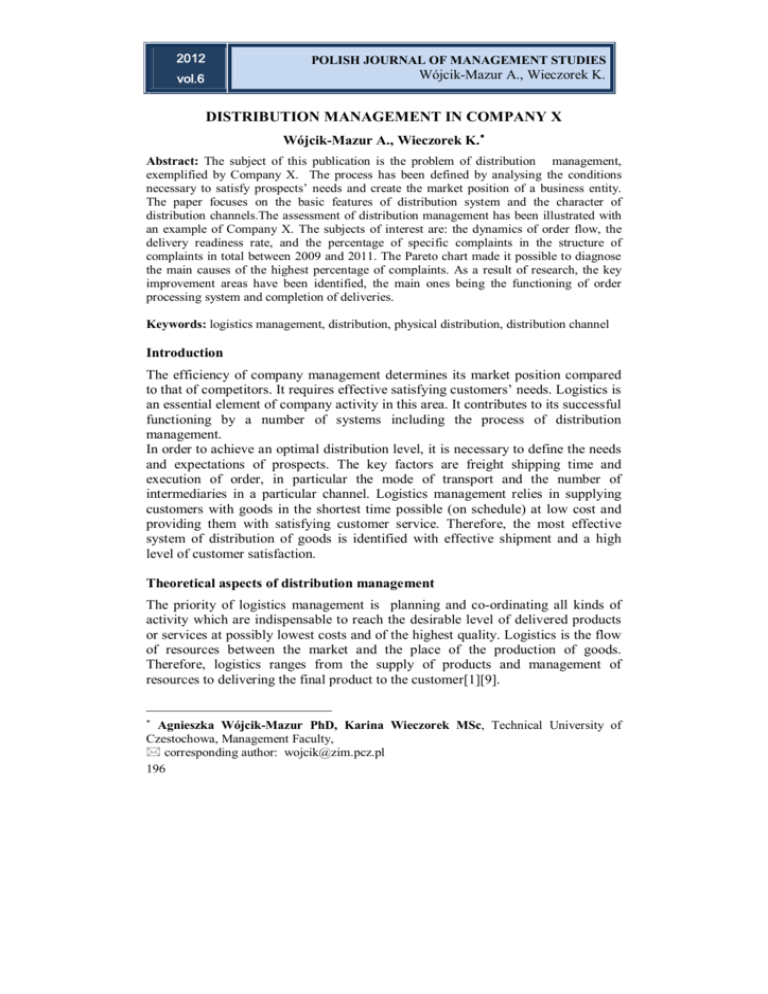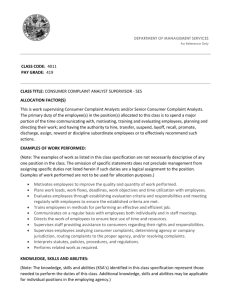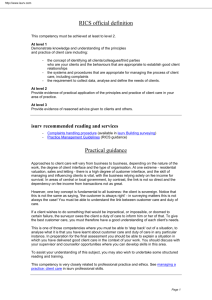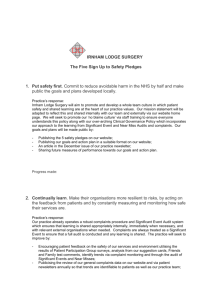distribution management in company x
advertisement

2012 POLISH JOURNAL OF MANAGEMENT STUDIES vol.6 Wójcik-Mazur A., Wieczorek K. DISTRIBUTION MANAGEMENT IN COMPANY X Wójcik-Mazur A., Wieczorek K. Abstract: The subject of this publication is the problem of distribution management, exemplified by Company X. The process has been defined by analysing the conditions necessary to satisfy prospects’ needs and create the market position of a business entity. The paper focuses on the basic features of distribution system and the character of distribution channels.The assessment of distribution management has been illustrated with an example of Company X. The subjects of interest are: the dynamics of order flow, the delivery readiness rate, and the percentage of specific complaints in the structure of complaints in total between 2009 and 2011. The Pareto chart made it possible to diagnose the main causes of the highest percentage of complaints. As a result of research, the key improvement areas have been identified, the main ones being the functioning of order processing system and completion of deliveries. Keywords: logistics management, distribution, physical distribution, distribution channel Introduction The efficiency of company management determines its market position compared to that of competitors. It requires effective satisfying customers’ needs. Logistics is an essential element of company activity in this area. It contributes to its successful functioning by a number of systems including the process of distribution management. In order to achieve an optimal distribution level, it is necessary to define the needs and expectations of prospects. The key factors are freight shipping time and execution of order, in particular the mode of transport and the number of intermediaries in a particular channel. Logistics management relies in supplying customers with goods in the shortest time possible (on schedule) at low cost and providing them with satisfying customer service. Therefore, the most effective system of distribution of goods is identified with effective shipment and a high level of customer satisfaction. Theoretical aspects of distribution management The priority of logistics management is planning and co-ordinating all kinds of activity which are indispensable to reach the desirable level of delivered products or services at possibly lowest costs and of the highest quality. Logistics is the flow of resources between the market and the place of the production of goods. Therefore, logistics ranges from the supply of products and management of resources to delivering the final product to the customer[1][9]. Agnieszka Wójcik-Mazur PhD, Karina Wieczorek MSc, Technical University of Czestochowa, Management Faculty, corresponding author: wojcik@zim.pcz.pl 196 POLISH JOURNAL OF MANAGEMENT STUDIES 2012 Wójcik-Mazur A., Wieczorek K. vol.6 Distribution, the role of which is to make goods accessible in suitable quantity, quality, time and place, in line with customers’ requirements, is one of the basic elements of the macrologistics system. The area of distribution determines the activity of manufacturing system, influences the pace of production, creates various logistic processes, enables contact with the target customers and recognizes their expectations [5][17]. Commercial sources give different definitions of distribution, including the term physical distribution. Conventionally, distribution refers to the range of activities which are to ensure that customers have access to goods of required quality and quantity, in the place and at the time which meet their expectations. Physical distribution is “the collective term for activities involved in the shipment of goods from points of production to final points of sale. In some cases it also refers to transportation of primary commodities from their sources to the beginning of production line. Physical distribution includes: freight transportation, storage and handling of goods, protective packaging, inventory management, prime location of plants and warehouses, accepting orders, marketing forecast and customer service” [6][13] Physical distribution is, therefore, the flow of goods to consumers through definite network including both transportation and storage, generally referred to as logistics[8]. The basic element characterising the structure of physical distribution is the flow of materials and products which has periods in which a product or material do not undergo changes. This flow is most often the physical transportation of goods[15]. Gołembska considers distribution to be one of the basic elements of the logistics chain which, besides the process of production, is responsible for supplying customers with products in the place and at the time which meet their demands. In the author’s opinion, distribution consists in channelling goods to people. The division can take the form of both purchase-sale transactions and services. As for enterprises, it is a process of products’ transfer from producers to consumers [7]. According to S. Ramachandran and C. V. Ramanan, distribution is a process based on transferring goods from the place where they were produced to consumers or final users. The authors are of the opinion that the process of distribution should be in keeping with the principles of fair marketing. These rules postulate meeting consumers’ requirements and assume creating stable and foreseeable market, making the flow of goods possible as the process of distribution includes the elements of distribution itself as well as elements of selling process[14]. The sources give different definitions of distribution. They are connected with distribution management. From this perspective the distribution process is defined as the element of logistics focusing on the physical flow of goods from the producer to consumer with the use of the various distribution channels. They are equipped in transportation, storage, commercial records and information systems adjunct to above-mentioned mechanisms and auxiliary to the flow of records. Distribution management is defined as the sum of physical distribution and distribution channels[11]. 197 2012 POLISH JOURNAL OF MANAGEMENT STUDIES vol.6 Wójcik-Mazur A., Wieczorek K. The decisions made by modern enterprises, defining the choice of the target market and planning the scope of market activity, reflect distribution purposes. These purposes can range from sales volume to different kinds of indicators referring to profitability, viability and distribution expenses. They can also include the improvement in accessibility of goods as well as a shorter time of customer service. Defining them is a significant stage in planning distribution channels since the degree to which the distribution purposes have been realised has a great influence on the evaluation of how efficient the activity of an enterprise is [12][16]. The choice of a suitable channel of distribution should be preceded by the analysis of several key factors, for it is the channel that determines the development of the whole strategy of the given enterprise, and therefore it should be in line with elements such as production, communication and decisions relating to pricing. Those elements concern: the producer, intermediaries, factors of production, market factors and environmental factors [3]. The basic criterion of the choice of distribution channels is the projected ability of an enterprise to achieve the purposes it aims at. The distribution channel is an essential element of the process of distribution and, as part of it, it is defined as “path” which determines the way of goods’ flow with the help of intermediaries [10]. There are different kinds of distribution channels. They are classified by the number of intermediaries, namely: - a direct channel - this structure is characterised by the fact that the supplier has and manages all the goods in the chain and delivers them directly to the final customer; - a level one channel – this structure has a single intermediary between the manufacturer and a consumer so that it can be possible to expand the area of the served market and provide more specialised goods in order to meet customers’ needs; - a level two channel - it requires two intermediaries in supplying the recipient with the final product. These middlemen are able to deal with a much larger market than in the direct or level one channel; - a multi-level channel – it has the same structure as a level two channel but it uses more levels of intermediaries - an OEM channel – it refers to the situation in which one supplier (OEM manufacturer) produces goods which are products or components reused or incorporated into a new product with a new brand name[4]. Distribution network refers to a set of physical functions such as storage facilities and transportation systems with largest geographical range possible. It also includes commercial records and distribution logistics management with a significant role of information flow[2]. The theoretical foundation of distribution of goods presented above is the basis for the evaluation of the distribution system of Company X contained in the further part of this publication. 198 POLISH JOURNAL OF MANAGEMENT STUDIES 2012 Wójcik-Mazur A., Wieczorek K. vol.6 The efficiency of managing the distribution process In order to present the empirical analysis, this paper presents the results of a case study of Company X. Company X is a Polish nationwide producer fully funded by Polish capital. The company is currently listed among ten largest in Poland out of 200 companies of the same trade. According to the retail research conducted by Nielsen Retail Research in 2011, Company X ranks third as for quantity and value on account of market sales of flavoured water with the market share on the level of 5,03 % and 5,14% respectively. The sales of the company products have increased by 2631% in the last twenty-five years. The growing market competitiveness, resulting from the development and modernization of infrastructure, implementing new production technologies and information systems which streamline sales and distribution, makes it possible for the company to enhance its market position. The company obtains external financing including EU funds[20]. The assortment of the company can be divided into three main categories: - bottled water; - fizzy drinks; - still drinks. Towards the end of 2011 Company X employed more than 200 people and cooperated with approximately 130 workers on a discontinuous employment basis. It has 64 owners and is in possession of three branches occupying 110,136 m2 altogether [19]. Distribution which is the physical flow of products and services to final users is one of the basic areas of the production company activity. Therefore, the aim of every company is to ensure the right quality. The factors which have the greatest influence on the level of distribution are: the time of supplying the user with a product, the quality of delivery, the kind of channel, the choice of intermediaries etc. Company X uses specialist business sections that deal with servicing particular groups of clients. In order to guarantee high quality of servicing different categories of companies, there have been selected different areas servicing particular distributors. The areas in the sales department are as follows: - retail trade, referring to servicing satellite shops - modern trade; - traditional trade; - HORECA channel, sector of the food service industry including hotels and restaurants Company X distributes its goods only on to the domestic market. To ensure the right level of distribution, particular people are appointed to deal with the distribution of products in a specific geographic area, marked off by the management of the regional logistics department. Eight basic geographic areas are shown in Table 1. 199 2012 POLISH JOURNAL OF MANAGEMENT STUDIES vol.6 Wójcik-Mazur A., Wieczorek K. Table 1. Classification of the geographic areas in which Company X operates Area number I. II. III. IV. V. VI. VII. VIII. Characteristics of the area Part of Łódź Voivodeship, including Łódź, Piotrków Trybunalski, Tomaszów Mazowiecki and part of Silesian Voivodeship , including Częstochowa and vicinity. The rest of Silesian Voivodeship, i.e. Katowice, Gliwice and vicinity. Part of Lower Silesian Voivodeship, including the region of Wrocław and Legnica, as well as Opole Voivodeship and Greater Poland Voivodeship, mainly Zielona Góra. Voivodeships: Lesser Poland (Cracow and the vicinity, the region of Nowy Sącz), Subcarpathian Voivodeship ( Rzeszów and Przemyśl among others). Part of Lublin Voivodeship, i.e. Lublin and vicinity, also Świętokrzyskie Voivodeship including Kielce, Masovian Voivodeship, only the area of Radom. Podlaskie Voivodeship (Białystok) and the rest of Masovian Voivodeship (Warsaw). Part of Pomeranian Voivodeship, including Gdańsk, Sopot, WarmianMasurian Voivodeship (Olsztyn) and Kuyavian-Pomeranian Voivodeship, Włocławek region Greater Poland Voivodeship - Poznań and West Pomeranian Voivodeship (Szczecin, Koszalin). Source: Own elaboration from data on www.przedsiębiorstwo”X”.com.pl (lecture 20.07.2011). The data was collected directly from Company X The major components of the process of distribution are: merchandising, the distribution channel and the customer service. The distribution of a finished product should be managed by following the basic rules of effective goods’ flow, i.e. the transportation of goods to a predetermined place, at the right time and in the right quantity, ensuring the optimised purveyance. In order to assess the effectiveness of distribution system of Company X, quantitative and qualitative indicators have been shown in Table 2. They are based mainly on the analysis of dynamics, readiness of delivery ( calculated as the quotient of the number of deliveries managed promptly and the number of deliveries in total; numbers displayed as percentages) and the ratio of deliveries with complaints against them to the number of deliveries in total (%)[18]. The data presented in Table 2 indicates that the number of orders placed for the company’s products has been on a downward trend in the analysed period. 2010 saw a business decline by 1,46 percentage point in comparison to 2009. In 2011 a similar situation took place. The number of orders dropped by 14,33 percentage point compared with 2010. This situation may indicate a further fall in the number of the company’s orders, and consequently a fall in income and weakening market 200 POLISH JOURNAL OF MANAGEMENT STUDIES 2012 Wójcik-Mazur A., Wieczorek K. vol.6 position. It is probably a result of a lot of competition from other firms which have revolutionised the flavoured water market. Therefore, Company X should work out new strategies and expand into other markets. As far as readiness of delivery is concerned, every company aims at the indicator equal to 100%. The data in Table 2 shows that the best indicator for Company X was in 2009. It was a result of the order processing system modernization which at that time eliminated the risk of errors. In the other periods there was a fall in delivery readiness amounting to 99,92 and 99,93 % in 2010 and 2011 respectively. In that period a few-day system errors occurred, resulting in delivery delay. Table 2. Quantitative and qualitative indicators of the distribution system in Company X in 2009 – 2011 Itemisation 2009 2010 Total number of deliveries 16996 16748 Delivery dynamics with the use of chain indexes ( %) 98,54 85,67 2010 2011 Number of prompt deliveries 16992 16735 Readiness of delivery (%) 99,976 99,922 Total number of complaints about 38 48 delivery Ratio of complaints to the number of 0,22 0,29 deliveries (%) Structure of complaints in total ( %) Legitimate complaints 89,47 75,00 Illegitimate complaints 10,53 25,00 Structure of legitimate complaints (%) Quality of a product 23,53 11,11 Logistics and storage 64,71 52,78 Customer service 11,76 30,56 Others 0 5,56 2011 14348 14338 99,930 59 0,41 69,49 30,51 9,76 65,85 14,63 9,76 Source: Own elaboration from data collected from Company X In spite of a slight increase in delivery readiness in 2011, the situation of Company X is difficult, especially due to the fall in the number of deliveries. If the number of goods delivered decreases, stagnation and the greater number of errors lowers delivery readiness of a company. This difficult situation is also reflected in the greater number of complaints made about deliveries in comparison to the total number of deliveries managed. In 2009 it was 0,22%, in 2010 it was 0,29% and in recent years it has amounted to 0,41%. The data clearly indicates a much greater number of both legitimate and illegitimate complaints. The most frequent complaints were those about logistics and storage (64,71% in 2009, 52,78% in 2010 and 65,85% in 2011). In 2009 they were followed by the complaints about the quality of products (23,53%), whereas in 2010 and 2011 complaints regarding customer service (30,56% and 14,63% respectively). Details of the structure of 201 2012 POLISH JOURNAL OF MANAGEMENT STUDIES vol.6 Wójcik-Mazur A., Wieczorek K. complaints are shown below. The Pareto chart highlights ten most frequent reasons for complaints between 2009 and 2011(Chart 1). The numbering on the chart is equivalent to the classification of the complaints, listed in Table 3. Table 3. Classification of complaints regarding delivery in Company X Item number 1 2 3 4 5 6 7 8 9 10 Reasons for complaints Entering a wrong order into the computer system Mechanical damage to bottles during shipment Completion of deliveries - excess goods/incomplete delivery Short shelf life Handover errors in the delivery of products to the recipient Goods loading errors Excessive amounts of yeast, mould and micro-organisms in a drink Incomplete delivery due to carrier’s fault Errors in communication with a buyer Residues in drinks Source: Own elaboration from data collected from Company X Figure 1 shows the ratio of particular complaints classified in Table 3 to total number of complaints, as well as the cumulative percentage of complaints. Figure 1. The Pareto chart for 2009-2011 Source: Own elaboration from data collected from Company X The data presented in Figure 1 implies that three kinds of errors (approx. 30%) result in 60% of complaints. They concern mainly entering a wrong order into the computer system, mechanical damage to supplies during the shipment as well as inconsistencies between ordered and invoiced products and actual state of 202 POLISH JOURNAL OF MANAGEMENT STUDIES 2012 Wójcik-Mazur A., Wieczorek K. vol.6 deliveries. The data suggests the problem areas in the distribution process which require some improvements. The problems connected with entering a wrong order into the computer system spring from the faulty system of managing orders. Fault could also lie with workers who are untrained to manage deliveries. The complaints regarding mechanical damage to supplies may be the result of carriers’ negligent driving or antiquated transportation vehicles. As for errors in completion of deliveries, the problem is work overload of the staff dealing with accepting orders and invoicing products, which means insufficient workers in Company X. Analysing the above chart, the company should focus on modernising the process of distribution, particularly in the problem areas, namely the system of managing orders, staff training, modernisation of transport and taking on new employees. In response to enumerated problems, the company signalled readiness to implement changes and improve the system of distribution, reduce the instances of errors, and consequently reduce the resultant costs. Summary Distribution has an extremely important role in operation of any production company. It affects every company’s profits and market share. The effectiveness of distribution means supplying customers with goods of high quality and required quantity, at a fair price, in a prearranged place, at the right time. Therefore, the process of distribution requires many activities consisting in gathering information and passing it on to the right company section, searching interesting offers, trade networking, negotiating and concluding business contracts. That is why effectiveness of distribution channels is essential in order to provide final users with goods and products. The distribution process has a great influence on the level of customer satisfaction. Thus, every company aims at its good management. The qualitative and quantitative assessment of the distribution system in Company X indicates a steady decrease in effectiveness of distribution management. It has been noticeable since the moment of dynamics analysis of deliveries and observed a considerable fall between 2010 and 2011. Delivery readiness, which conditions the right functioning of a company is decreasing steadily, in spite of its satisfactory level at the moment. The ratio of particular complaints to the total number of complaints also contributes to unfavourable sales forecast. The Pareto chart clearly indicates three problem areas which result in 60% of complaints. The company ought to focus on the improvement in distribution process, as all of the above factors have a great impact on its workings. Thus, it is the company’s task to generate higher interest for the brand, and consequently to increase the demand for its products, which will then lead to expansion onto other markets. The company should also aim at reducing human errors and those caused by technology failure as well as increase the efficiency of its employees. 203 2012 POLISH JOURNAL OF MANAGEMENT STUDIES vol.6 Wójcik-Mazur A., Wieczorek K. References: [1]. Ailawadi S. C., Singh R.: Logistics management. Prentice Hall of India Private Limited. New Delhi 2005, p.18. [2]. Brandimarte P., Zotteri G.: Introduction to distribution logistics. Statistics in practice. John Wiley & Sons Inc. Canada 2007, p. 4 [3]. Cant M. C., Strydom J. W., Jooste C. J., Plessis du P. J.: Marketing Management. Juta & Co. Ltd. Cape Town 2006, p. 413. [4]. Dent J.: Distribution channels. Understanding and managing channels to market. Kogan Page Limited. UK 2008, p. 11-13 [5]. Fechner I., Szyszka G.: Logistyka w Polsce. Raport 2005. Biblioteka Logistyka. Poznań 2006, p. 68 [6]. Fertsch M.: Słownik terminologii logistycznej. Instytut Logistyki i Magazynowania. Poznań 2006, p. 45-46 [7]. Gołembska E.: Kompendium wiedzy o logistyce. Wydawnictwo Naukowe PWN. Warszawa 2007 [8]. Gorchels L., Marien E., West Ch.: The manager’s guide to distribution channels. The McGraw-Hill Companies 2004, p. 7 [9]. Grabara J., Kot S.: Theoretical Frames for Designing Reverse Logistics Processes [w:] Review of General Management Vol.9 nr 1, 2009. [10]. Hastings R. D.: Channel sales and management in distribution. Businessman 101, 2011, p. 5 [11]. Kapoor S. K., Kansas P.: Basics of distribution management: a logistical approach. Asoke K. Ghosh, Prentice-Hall of India Private Limited. New Delhi 2005, p. ix-2 [12]. Kozłowski R., Sikorki A.: Podstawowe zagadnienia współczesnej logistyki. Oficyna a Wolters Kluwer business. Kraków 2009, p. 109-110 [13]. Otola I., Szczupak L. (red.) Logistics and Organizational Aspect of Company Management, Wyd. Politechniki Częstochowskiej, Częstochowa 2010 [14]. Ramachandran S., Ramanan C. V.: Distribution and sales management. Allied Published PVT. LTD. New Delhi 2005, p. 3 [15]. Rushton A., Croucher P., Baker P.: The handbook of logistics & distribution management. Kogan Page Limited. UK 2010, p. 13 [16]. Skowron-Grabowska B.: Nowe koncepcje zarządzania w łańcuchach dostaw, [w:] Gospodarka Materiałowa i Logistyka nr 7/2007 [17]. Skowron-Grabowska B., Mrozik T.: Zarządzanie logistyczne w przedsiębiorstwach, [w:] Determinanty zarządzania przedsiębiorstwami wobec zmian otoczenia rynkowego, pod redakcją B. Ślusarczyk, J. Urbańskiej, Wyd. Politechniki Częstochowskiej, Częstochowa 2008 [18]. Twaróg J.: Mierniki i wskaźniki logistyczne. Biblioteka Logistyka. Instytut Logistyki i Magazynowania. Poznań 2005, p. 58-61 [19]. Wawrzyniak B.: Przedsiębiorstwo „X”. 50 lat dla Ciebie i Twojej Rodziny. Zakład Poligraficzny A. Połać. Myszków 2009 [20]. Internal information of Company X 204 POLISH JOURNAL OF MANAGEMENT STUDIES 2012 Wójcik-Mazur A., Wieczorek K. vol.6 ZARZĄDZANIE PROCESEM DYSTRYBUCJI W PRZEDSIĘBIORSTWIE „X” Streszczenie: Przedmiotem rozważań w niniejszej publikacji jest problematyka zarządzania procesem dystrybucji analizowana z perspektywy przedsiębiorstwa „X”. Proces ten zdefiniowano poprzez pryzmat zaspokajania potrzeb potencjalnych klientów oraz kreacji pozycji rynkowej podmiotu gospodarczego, koncentrując się na podstawowych cechach systemu dystrybucji oraz specyfice znaczących w tym aspekcie kanałów. Ocenę zarządzania procesem dystrybucji przedstawiono na przykładzie przedsiębiorstwa „X”. Przedmiotem badań była analiza dynamiki liczby zamówień, wskaźnika gotowości dostawczej, jak również wskaźnika udziału poszczególnych grup reklamacji w strukturze reklamacji ogółem przeprowadzona dla okresu badawczego 2009-2011. Implementacja wykresu Pareto-Lorenza umożliwiła diagnozę głównych obszarów generujących największy procent reklamacji. W efekcie prowadzonych badań zdefiniowano kluczowe płaszczyzny wymagające modernizacji w tym w szczególności funkcjonowanie systemu obsługi zamówień jak i trudności z zakresu fizycznego dostarczania produktów oraz kompletacji dostaw. X公司的配電管理 摘要:受本刊物的發行管理的問題,由X公司為例,該工藝已定義的分析的必要條件 ,以滿足潛在客戶的需求,創造出一個商業實體的市場地位。本文的重點分佈系統 的基本功能已經說明了一個例子,X公司的利益主體和分銷管理的的分佈渠道。評估 的字符:訂單流,交付完好率的動態變化,並總在2009年和2011年之間的比例結構 中的具體投訴的投訴。帕累托圖,它可以診斷的主要的投訴比例最高的原因。研究 的結果,關鍵改進領域已被確定,主要是訂單處理系統的運作和完成交付。 205








